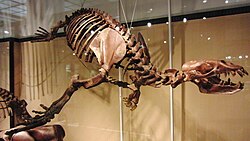| Desmatophocidae Temporal range: Early to Late Miocene | |
|---|---|
 | |
| Skeleton of Allodesmus sp. at the National Museum of Nature and Science, Tokyo, Japan | |
 | |
| Holotype skeleton of Atopotarus courseni at the Natural History Museum of Los Angeles County | |
| Scientific classification | |
| Domain: | Eukaryota |
| Kingdom: | Animalia |
| Phylum: | Chordata |
| Class: | Mammalia |
| Order: | Carnivora |
| Parvorder: | Pinnipedia |
| Superfamily: | Otarioidea |
| Family: | † Desmatophocidae |
| Genera | |
Desmatophocidae is an extinct family of pinnipeds closely related to either the eared seals and walruses [1] or to the earless seals. [2] [3] These animals were the first group of large-bodied pinnipeds to evolve, first appearing in the Early Miocene, with no direct modern descendants. [4] Desmatophocids have only been found to live in the North Pacific, with fossils being found in Baja California, California, Oregon, Washington, and Japan. [5]
The group is generally known for having large orbits, bulbous cheek teeth, and forelimbs similar to extant eared seals. [4]



